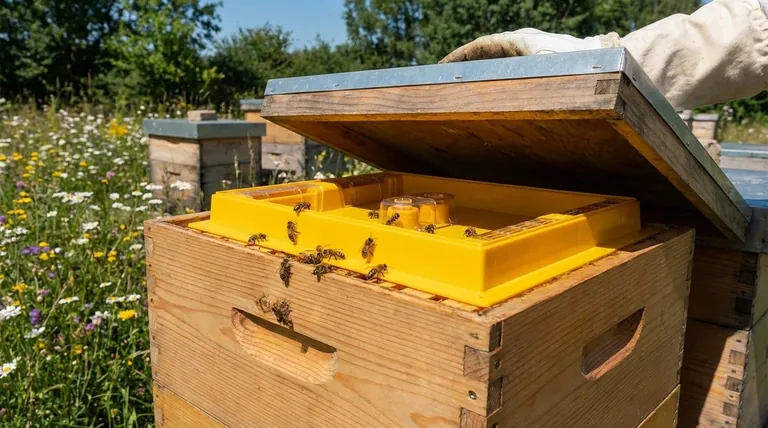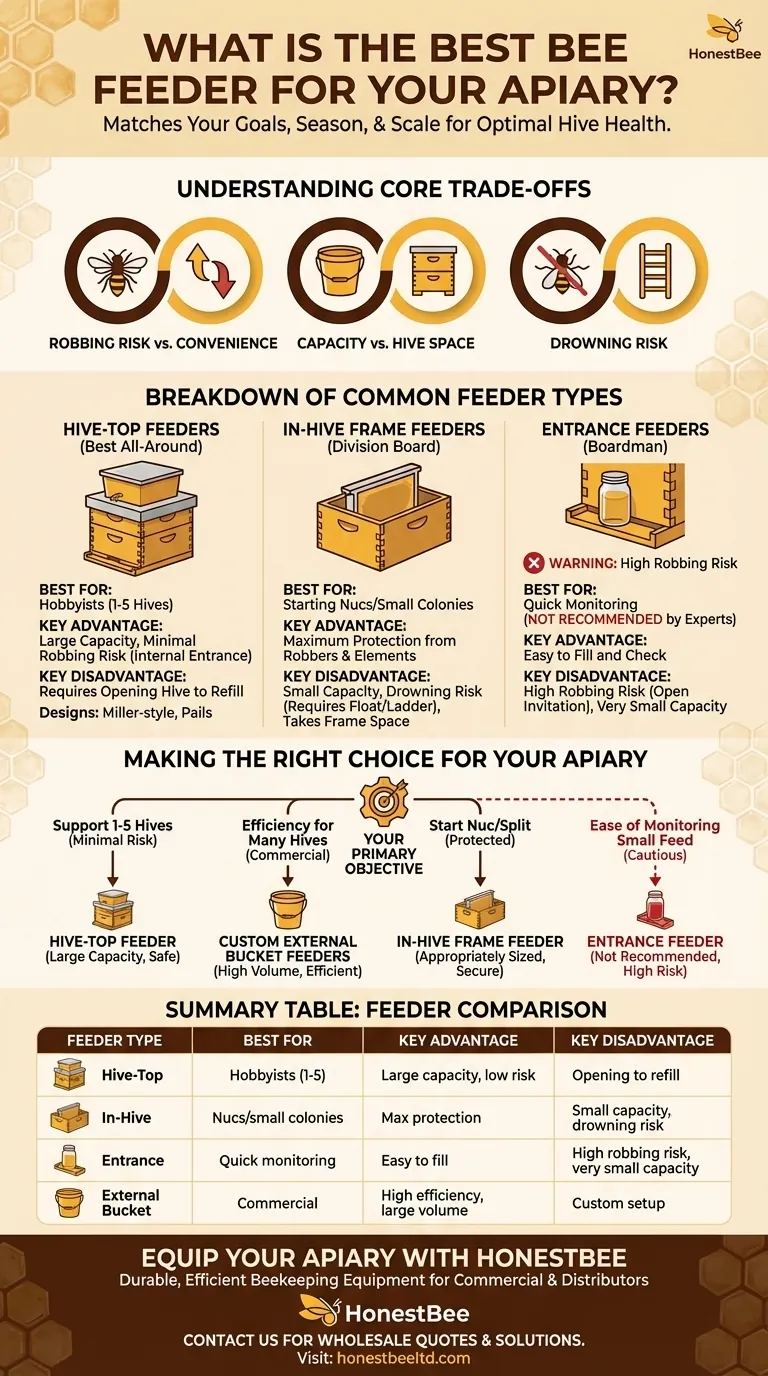The best bee feeder is the one that best matches your specific goals, the season, and the number of hives you manage. For a beekeeper with a few hives, a hive-top feeder (such as a Miller-style or round feeder) offers the best combination of capacity, safety, and ease of use. For large-scale or commercial operations, external bucket feeders are the standard due to their efficiency and large volume.
Choosing the right bee feeder isn't about finding a single "best" product. It's about understanding the core trade-offs between capacity, accessibility, and the risk of inciting robbing, then aligning your choice with the scale and purpose of your beekeeping.

Why Feeder Choice Matters
Feeding bees is a strategic intervention, not a routine task. You may need to provide sugar syrup to establish a new colony, support them through a nectar dearth, or help them build up stores for winter.
The type of feeder you use directly impacts the effectiveness of this support and the health of your hive. A poor choice can lead to drowned bees, attract pests, or trigger "robbing"—a destructive event where bees from other hives attack your colony to steal its resources.
A Breakdown of Common Feeder Types
Each feeder design presents a different set of advantages and disadvantages. Understanding these is the key to making an informed decision.
Hive-Top Feeders
These feeders sit on top of the uppermost hive box, directly under the outer cover. They come in various styles, including rectangular "Miller" feeders and large pails or buckets modified for feeding.
Hive-top feeders are often considered the best all-around option for hobbyists. They hold a large volume of syrup, minimizing the frequency of refills. Most importantly, the entrance is contained within the hive, which dramatically reduces the risk of attracting robber bees from other colonies.
They are also versatile, with many designs fitting standard 8-frame and 10-frame Langstroth equipment of any depth.
In-Hive Frame Feeders
Also known as division board feeders, these are thin, plastic containers shaped like a standard hive frame. They are placed inside a hive box in place of one or two of the wooden frames.
Their primary advantage is that they are completely enclosed within the hive, offering maximum protection from robbers and the elements. This makes them excellent for starting small nucleus colonies or providing a small amount of feed without exciting other hives.
However, they hold less syrup than top feeders and require you to fully open the hive to refill them. Many older or cheaper designs also pose a significant drowning risk if they don't include floats or a textured "ladder" for the bees to climb.
Entrance Feeders
These small feeders, often called Boardman feeders, sit at the entrance of the hive and typically use an inverted mason jar to hold the syrup.
While they are very easy to fill and monitor, most experienced beekeepers advise against them. Their placement at the front door of the hive is an open invitation for robbing. The scent of syrup attracts bees from strong neighboring hives, who may overwhelm and destroy your colony to get to the feed.
Their capacity is also very small, making them impractical for serious feeding efforts like preparing a hive for winter.
Understanding the Trade-offs
Every feeder is a compromise. Your job is to pick the compromise that best suits your situation.
Robbing vs. Convenience
This is the most critical trade-off. Entrance feeders are the most convenient to refill but pose the highest risk of robbing. Hive-top and in-hive feeders require more work to access but are significantly safer for your colony because the feed source is protected.
Capacity vs. Hive Space
A hive-top feeder offers the largest capacity without sacrificing any space inside the brood nest, where the queen lays eggs. An in-hive frame feeder has a smaller capacity and takes the place of one or two frames that could otherwise be used for brood or food storage.
Drowning Risk
Bees can and will drown in open pools of syrup. Hive-top feeders are generally safer, as they incorporate screened-off areas or floats that allow bees to access the syrup without falling in. In-hive frame feeders can be a major drowning hazard unless you ensure they have a built-in ladder or you add a float (like a piece of wood or plastic mesh).
Making the Right Choice for Your Apiary
Select your feeder based on your primary objective and the scale of your apiary.
- If your primary focus is supporting 1-5 hives with minimal risk: A hive-top feeder is your best choice for its large capacity and excellent protection against robbing.
- If your primary focus is efficiency for many hives: Custom-made bucket feeders placed on the hive tops are the commercial standard for a reason.
- If your primary focus is starting a small nucleus colony or split: An in-hive frame feeder provides a protected, appropriately-sized resource that won't get robbed out.
- If your primary focus is ease of monitoring a very small amount of feed: An entrance feeder can be used cautiously during a strong nectar flow when robbing is less likely, but it is generally not recommended.
By matching the feeder's design to your specific goal, you provide effective support for your colonies and become a more proficient beekeeper.
Summary Table:
| Feeder Type | Best For | Key Advantage | Key Disadvantage |
|---|---|---|---|
| Hive-Top Feeder | Hobbyists (1-5 hives) | Large capacity, minimal robbing risk | Requires opening hive to refill |
| In-Hive Frame Feeder | Starting nucs/small colonies | Maximum protection from robbers | Small capacity, can drown bees |
| Entrance Feeder | Quick monitoring (not recommended) | Easy to fill and check | High robbing risk, very small capacity |
| External Bucket Feeder | Commercial/Large-scale apiaries | High efficiency, large volume | Requires custom setup |
Equip Your Apiary with the Right Feeders from HONESTBEE
Choosing the correct feeding equipment is critical for colony health and productivity. Whether you manage a few backyard hives or a large commercial operation, HONESTBEE supplies the durable, efficient beekeeping equipment you need to succeed.
We provide wholesale-focused solutions for:
- Commercial Apiaries: Scale your feeding operations with high-capacity bucket and hive-top feeders.
- Beekeeping Equipment Distributors: Source reliable feeders and supplies for your customers.
Let us help you optimize your feeding strategy. Contact HONESTBEE today to discuss your specific needs and request a wholesale quote.
Visual Guide

Related Products
- Professional Hive Top Bee Feeder for Beekeeping
- HONESTBEE Entrance Bee Feeder Professional Hive Nutrition Solution for Beekeeping
- Professional Hive Front Entrance Bee Feeder
- HONESTBEE Entrance Bee Feeder Efficient Hive Front Liquid Feeding Solution for Beekeeping
- Boardman Entrance Bee Feeder Durable Galvanized Steel and Wood Construction for Beekeeping
People Also Ask
- Do I need an inner cover with a hive top feeder? Optimize Your Hive Setup for Healthy Bees
- What are the advantages of hive top feeders? Maximize Feeding Efficiency for Your Apiary
- How to use a top feeder in a beehive? A Guide to Effective Beehive Feeding
- How is the plywood floor fitted into the hive-top feeder? Ensure Longevity with a Floating Floor Design
- What are the features of top feeders for bees? Maximize Hive Health with Safe, High-Capacity Feeding



















